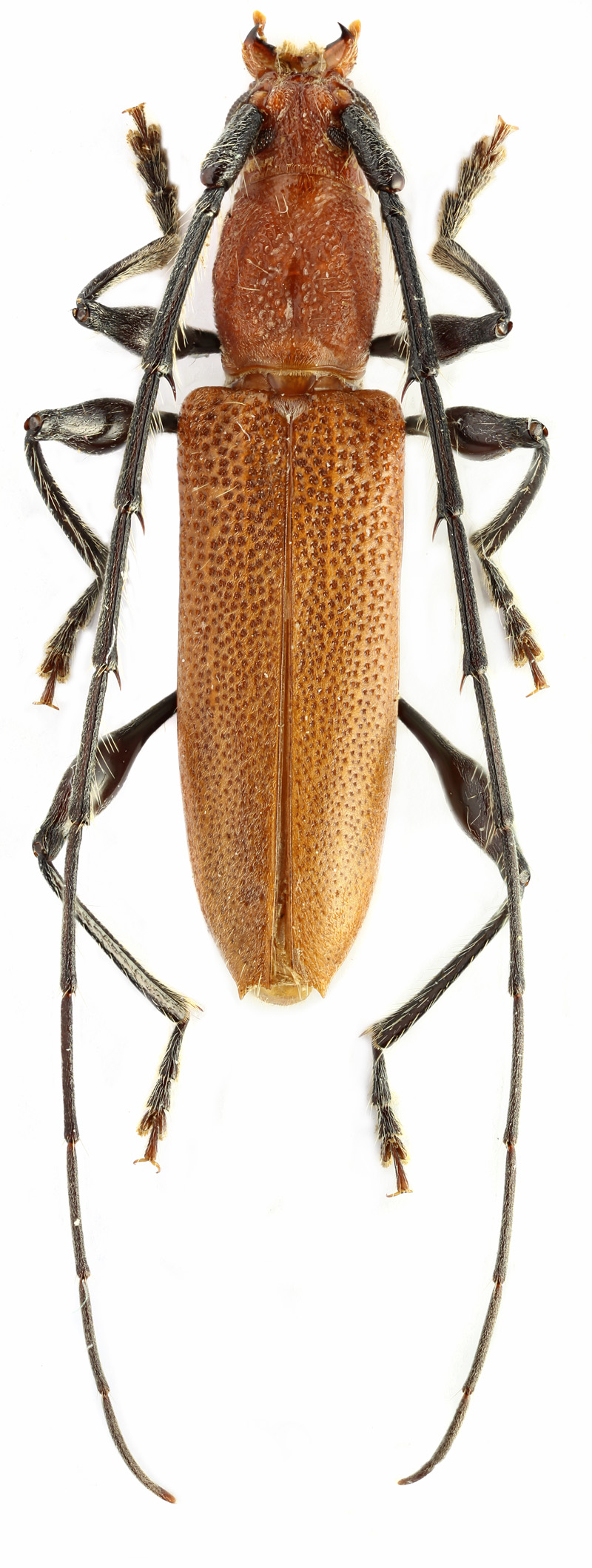| Author |
 Topic Topic  |
|
|
Max
Member Rosalia
  
Russia
721 Posts |
 Posted - 11/06/2011 : 22:09:05 Posted - 11/06/2011 : 22:09:05



|

Help me, please, with this Allotraeus.
I have big doubts about the species. Probably, orientalis (White, 1869)(???) or rubriventris...
Metathorax with hind coxae is dark-brown, abdomen is red, 13 mm,
C Vietnam, Lam Dong prov. |
|
|
Francesco
Forum Admin
    
Luxembourg
9454 Posts |
 Posted - 12/06/2011 : 13:10:16 Posted - 12/06/2011 : 13:10:16




|
I am not sure that it is A. (Nysina) orientalis (White, 1853). Certainly, it is not A. (Nysina) rubriventris Gressitt, 1937, which has a different pronotal sculpture and elytral apex (here the holotype).
Nonetheless, the authors (White, 1853, p. 110; Gahan, 1906, p. 153-4) never described the pronotal ridge of your specimens for A. orientalis.
By more carefully examining your specimen, I noticed that the left 6th antennomere has a broken spine (entire the right one); hence, I think that it belongs to Allotraeus (s. str.). |
 |
|
|
Max
Member Rosalia
  
Russia
721 Posts |
 Posted - 12/06/2011 : 22:59:12 Posted - 12/06/2011 : 22:59:12



|
Oh, and here all is uneasy... 
Many thanks for the links, Francesco! |
 |
|
|
Francesco
Forum Admin
    
Luxembourg
9454 Posts |
 Posted - 14/06/2011 : 21:36:53 Posted - 14/06/2011 : 21:36:53




|
According to BioLib, the only two species of Allotraeus (s. str.) are A. sphaerioninus Bates, 1877 and A. grahami Gressitt, 1937.
The latter one, with brown legs, is endemic from China, while the former, with black legs, is commonly quoted as endemic from Japan.
Nonetheless, this site provides a specimen from Korea and the book of Iconography of Chinese Longicorn quotes this species from Taiwan.
I think that some of those species are misidentified... however, it is a topic to be investigated further. |
 |
|
|
Max
Member Rosalia
  
Russia
721 Posts |
 Posted - 14/06/2011 : 22:38:37 Posted - 14/06/2011 : 22:38:37



|
It is really looks like spherioninus from Taiwan, (but I do not see spines on the antennae on the photo)
other variant
At the Japanese beetles the spines too short, on 3-5 antennomeres... only in females, perhaps?
In any case, my beetle has shorter elytra, in my view. New?  Possible Possible |
 |
|
|
Francesco
Forum Admin
    
Luxembourg
9454 Posts |
 Posted - 15/06/2011 : 12:54:05 Posted - 15/06/2011 : 12:54:05




|
Possible.
According to the descriptions I have (Plavilstshikov, 1932, Bestimmungstabellen) both males and females have spines on the antennomeres III-VI or III-VII, while Nysina has spines on the antennomeres III-V. Possibly some Nysina-species of BioLib are erroneously positioned or even described; I have to check all descriptions.
However, I have inserted the original description of A. spaherioninus here.
If you decide to describe a new species, it should be confronted with specimens from Japan, not from other countries.
I have some photocopies of the Fauna of Laos (Gressitt & Rondon), where only A. (Nysina) orientalis (typical locality: Assam) is mentioned.
Plavilstshikov (1931: 197-8) synonymised such species with Pseudallotraeus atripes Pic, 1923 from Laos... maybe they were not the same species... |
 |
|
|
Xavier
Scientific Collaborator
    
France
12220 Posts |
|
|
Max
Member Rosalia
  
Russia
721 Posts |
 Posted - 12/02/2019 : 21:55:47 Posted - 12/02/2019 : 21:55:47



|
M-mm.. Very similar to my beetle certainly. I really don`t see any differences other then the coloration. But my ex. have red underside except black metathorax and hind coxae (in contrast). And it`s brightly reddish not so sombre. Maybe this feature is not just variability..
Thank You Xavier! |
 |
|
| |
 Topic Topic  |
|


